Rifle battle cruisers. Unrealized projects. H. 2
I must say that the British sailors after the First World War fell into a very difficult situation. On the one hand, England, as of 1918-1919, had the strongest linear fleetwhich, in general, was approaching a multi-power standard. As of November 1918, there were 33 battleships in the KVMF, counting the “Canada” transferred to Chile, and 9 battle cruisers, except for the “big light cruisers” of the Koreges type. Total - 42 ships (or 41 without the Canada), and the rest of the world had 48 battleships and one battle cruiser (15 - the USA, 9 - Japan, 7 - France, Italy and Russia - 5 each, counting for the latter also “Emperor Alexander III ”, subsequently gone to Bizerte, Spain - 3, Brazil and Argentina - 2 and Turkey - 1 battle cruiser). But on the other hand, the base of the linear fleet of England was still pre-war and quickly became obsolete, while the fleets of the USA and Japan were replenished with the latest battleships and both of these countries began implementing large shipbuilding programs. As early as 1916, the United States adopted a very ambitious program to create 10 battleships and 6 battle cruisers, the war delayed these plans, but in 1918 Congress confirmed its resumption, and starting the next year, 1919, its funding was fully implemented. The Japanese (albeit not immediately) adopted their famous program "8 + 8". Both of these powers immediately began laying the latest battleships armed with 406-410-mm guns.
As a result, to the 1919 g the British were faced with the fact that their powerful fleet is rapidly becoming obsolete. Of the 9, the 4 battlecruisers were Invincible and Indefategebl type ships, which, in fact, were outdated before the outbreak of the First World War, and the remaining five (two types, Lion, Tiger, Ripales and Rinaun ") Because of the extremely weak defense had extremely limited combat utility. From the British 32 battleships (they “honestly handed over Chile to Canada), the 10 were outdated, ships that practically lost their combat value, armed with twelve-inch guns, the 11, although they had impressive 343-mm guns, were designed before World War I, and only the last ten “381-mm” battleships (5 type “Queen Elizabeth” and the same type “Royal Soverin”) could be considered quite modern. At the same time, the same US in 1919 g had 9 battleships with 356-mm guns (although the two earliest ships of the Texas type had steam engines as a power plant) and built an 3 battleship with 406-mm guns according to a new program, getting ready to lay more 7 battleships and 6 battlecruisers. The British, in response to these super efforts, had only the battle cruiser “Hood” in the completion and not a single capital ship in the construction plans.
In general, the British gradually realized that if something was not done, and urgently, then as the United States fulfills its last shipbuilding program, the Royal Navy may be in the shadow of the American. But here, to the “external enemy” the “internal enemy” was added - the country, exhausted by the nightmares of the First World War, was not at all eager to enter into the next, extremely expensive arms race. Moreover, confusion and reeling began in the Admiralty itself, because a number of sailors were quick to declare the linear forces obsolete and dying, while the future belongs to submarines and aviation.
In total, supporters of the resumption of the construction of battleships had to endure two desperate battles, and they won the first - according to the results of a comprehensive study of a specially created Post-War Development Commission, it was concluded that the battleships "have not yet lost their former value." However, the battle for the budget was lost - according to 1919 in August to the “10-year rule,” the budgets of the armed forces of England were to be determined not by their stated needs, but on the basis of the amounts that the treasury could find for them. Of course, the treasury immediately washed its hands ... It was possible to reverse this tendency later, when the Admiralty managed to "beat out" funds for the resumption of construction of linear forces from the financiers on 1921-1922 - laying out the four newest linear cruisers.
It must be said that the British took the projects of post-war ships designed to replenish the linear forces of the CWMF as seriously as possible. Of course, after the approval of the final Huda project, the designers and admirals continued to be entertained with various variants of the battlecruiser, made, in essence, in the same hull. But it was clear to everyone that even the final protection scheme for the Hud was, by and large, outdated and not suitable for the newest ships. And therefore, when the time had come to truly determine the performance characteristics of future battleships and battle cruisers, the British entered the best traditions of naval science and tried to determine ... no, not the tactical and technical characteristics of the ships of Japan and the USA, which were built or designed at that time of time. The British did not seek to create ships capable of resisting battleships or battlecruisers who were building now; they wanted to create ships that could fight both modern and advanced ships of this class.
After conducting various calculations with the "participation" of the most powerful British guns (381-mm and 457-mm caliber), the British concluded that the promising battleships of foreign powers in order to more or less acceptable protection against such powerful projectiles would eventually have to thicken The armor belt is up to 380 mm, and the armored deck is up to 178 mm. As we can see, after looking at the relevant directories, neither the Americans nor the Japanese at that time had planned anything like that. Kaga type battleships had an 305 mm board and total deck thickness (and not an armored deck) up to 160 mm in the thickest places. The South Dakota battleships had an 343 mm board and armored deck with a thickness of up to 89 mm, not counting structural steel decks. However, the British felt that the logic of the development of battleships would sooner or later lead the thickness of the deck and side armor to the above thicknesses.
In order to be able to overcome such a serious defense, the British needed a super-powerful gun, and the stakes were made on the 457-mm gun. At the same time, the British preferred the usual placement of such cannons in four two-turrets, but they understood that the three-gun turrets they disliked could give large weight and size advantages, and therefore, probably, for the first time in stories KVMF started to design three-gun installations simultaneously with two-gun. However, the British were ready to consider and 420-mm guns, and the new 381-mm long-barreled (fifty-caliber) artillery systems: however, such guns did not exist in nature, but the 457-mm still remained favorites. As part of the mine caliber, it was decided to return to using 152-mm artillery - from now on it was supposed to be placed in towers with a high level of mechanization of loading operations, and this leveled the main advantage of lighter 120-140-mm artillery systems - the ability to maintain a high rate of fire for a long time. The displacement of future battleships and battlecruisers was limited only by the dimensions of the available docks, as well as the Suez and Panama canals, but even here options were possible. Underwater protection had to withstand the hit of a torpedo containing explosives in 340 kg. The speed of the battleships was first named 25 knots, but then reduced to 23 knots, but the Americans still had their "pernicious" effect on TZ for the battle cruisers - the British wanted to set the bar on 33,5 first, under the impression of the Lexington's 33,5-node speed. knots, but then the anger was replaced with mercy, allowing to reduce the speed to 30 knots. The range should have been 7 000 miles on 16 nodes.
The first projects of the battleship of the new type (L.II and L.III, the figure indicated the presence of four two-gun or three three-gun towers), presented in June 1920, struck the imagination.
The L.II normal displacement was 50 750 tons, the main caliber was 8 * 457-mm guns, while the towers were arranged linearly (and not linearly sublime!), Anti-mine - 16 * 152-mm guns in two-gun towers. On the one hand, the linear layout of the artillery looked quite archaic, not allowing to fire at the bow and stern with the guns of the two towers, but the British calculated that already at elevation angle in 12 the second and third towers could fire above the first and fourth without damaging the last.
However, the real highlight of the project was the scheme of its reservation.
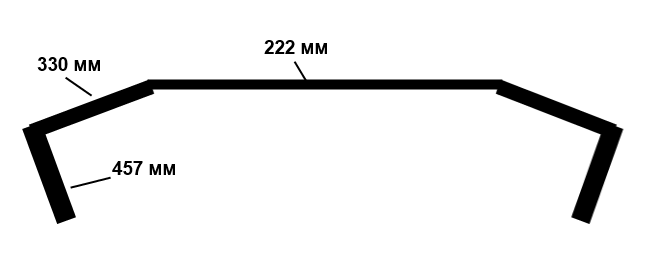
In this project, the British applied the “all or nothing” principle previously used by the Americans. The armor belt of more than 150 m length and an unusually powerful thickness of eighteen inches (457-mm) had a small height, only 2,4 m, while it was at a large angle to the sea surface (25 degrees). The horizontal part of the armor deck was also unprecedentedly powerful - 222 mm. But this section of the armored form was located significantly higher than the top edge of the 457 mm armor belt, which was quite unusual: the 330 mm bevels connected the armored form not with the bottom, but with the top edge of the armor belt!
There was a certain logic in this (at first glance, completely insane) layout. Without a doubt, 457 mm vertical section, and even at an angle 25 hail was able to withstand the blows of 457-mm projectiles, presumably that 222 mm armor (at least - at medium combat distances) could also reflect it. As for the 330 mm bevels, here, probably, their angle of inclination was chosen very carefully, so that at small and medium distances the projectiles, having a gentle trajectory, would simply ricochet from them. At long ranges, when the trajectory became more hinged, the bevel seemed to be “substituted” for the projectile, but due to its large thickness, it was probably still quite equivalent to 222 mm horizontal protection. At the same time, such a “tortoise-like” protection in cross-section provided a much larger amount of protected space, as compared with the classical armored deck with bevels.
Why are we in the article devoted to the latest British battlecruisers, paid so much attention to the project of the battleship? Only for one reason: in order to illustrate how in the post-war projects of "capital" ships the British were ready to disregard all kinds of traditions, established views on many things, for the combat effectiveness of future battleships and battlecruisers. And that's what they ended up with.
Displacement
Alas, the size of the Suez Canal, coupled with the docks in England, seriously limited the size of future warships - their normal displacement should not exceed 48 500 t, and admirals could not enter these dimensions. As a result, the sailors and designers had to balance the composition of weapons, armor thickness, power plant capacity in order to create balanced battleships and battle cruisers in the dimensions specified. In the draft of the cruiser “G-3”, the normal displacement was 48 400 t (with a normal supply of fuel 1 200 t).
Artillery
As the various variants of the battle cruiser were worked out, the shipbuilders came to the sad conclusion that even three-gun artillery mounts are still too heavy and 9 * 457-mm guns cannot be placed on the ship, unless you don’t sacrifice other parameters too much. As a result, it was decided to first confine to six 457-mm cannons in two towers, but the sailors looked askance at such an innovation — six barrels made it difficult to shoot, and as a result it was decided to lower the caliber first to 420-mm and then to 406 mm Interestingly, “just in case” it was stated that the three-gun 406-mm towers are close in weight to the 457-mm two-gun, so if the opposite decision is made, the placement of the 6 * 457-mm guns in the three two-gun towers will not require how many then a serious redesign of the ship.
In general, the return to 406-mm guns looked quite justifiable and reasonable step, but we should not forget that if it were not for the Washington Maritime Conference, Japan would have started (after two Kaga battleships) to build battleships (and probably battle cruisers) with 457-mm guns. Thus, His Majesty’s fleet in the battle cruiser unit ceased to “travel first class”. But the British would hardly have been worth grieving about this, in essence, there would have been some kind of “composition change” - while during WWI, England neglected to protect its battlecruisers in favor of large guns and speed, Germany limited itself to a smaller caliber with better protection, and such The approach is quite justified. Now, with the construction of the “G-3”, England would already have been in the position of Germany, and Japan - of England.
However, the situation was seriously complicated by the fact that the UK’s best engineers in the world, unfortunately, did not cope with the creation of an effective 406-mm artillery system and a three-gun installation for it. The fact is that, although the linear cruisers of the G-3 project were never embodied in metal, the 406-mm / 45 tools developed for them took place in the Nelson and Rodney battleships towers, which is why we are good enough imagine what the last British battlecruisers should have armed themselves with.
So, in the years preceding the First World War, the British held to the concept of “heavy projectile - low initial speed” and created quite impressive 343-381-mm guns. But when they were created, the British continued to use a rapidly becoming obsolete concept: the trunk wire structure, which had a sufficient number of flaws, such as, for example, great weight, but one of them was critical - long-barreled tools having such a design were bad. That is why the British did not succeed in the 305-mm / 50 gun, which, although it was put into service, did not suit the British in terms of shooting accuracy and a number of other parameters. As a result, the British were forced to return to guns with a barrel length of no more than 45 calibers, and in order to increase the power of such guns so that they were competitive with the latest German 305-mm / 50 tools, they increased the caliber to 343-mm ... and that is how they appeared super dreadnoughts.
At the same time, the concept of “low initial speed - heavy projectile” answered the “wire” construction of the barrels as well as possible, because for such an artillery system, a long barrel is not something that is not needed, but it is quite possible to do without it. However, according to the results of the First World War, the British came to the conclusion that they were wrong, and that the concept of “light projectile - high initial velocity” is more promising.
In support of this thesis, “British scientists” seemed to have made reasonable theses that in certain circumstances (for example, when they hit armored decks of ships at long distances), shorter “light” projectiles have the advantage of armor penetration before heavy (and, accordingly, long). All this was in theory the case, but alas, in practice, these advantages were of little value. However, the acceptance of such a concept was not in itself an evil - the same Germans created a very formidable 380-mm gun for their Bismarck type battleships. But this, again, occurred to a certain extent because the German artillery system had a long barrel (the longer it is, the longer the impact on the projectile of expanding powder gases, and this increases the initial velocity of the projectile - to certain limits, of course. In the barrel, kilometer long, the shell simply stuck).
So, the mistake of the British was that, by adopting the concept of “light projectile - high initial speed”, they retained the archaic wire structure of the trunk, limiting its length to 45 gauges. As a result, the resulting artillery system had a very low survivability. In order to somehow solve this issue, the British had to go to a significant reduction in the mass of powder charges, which, of course, greatly reduced the initial speed. The result was disappointing - instead of firing 929 kg with a projectile with an initial speed of 828 m / s, the British 406-mm / 50 provided such a projectile with only 785 m / s. As a result, instead of the all-destructive "hands of the gods", the English sailors received a very ordinary and, perhaps, worst-in-class artillery system - as we have said before, an American 406-mm gun mounted on Maryland-type battleships fired 1 016 kg with a projectile the initial speed is 768 m / s., and the Japanese 410-mm gun fired a projectile weighing exactly a ton with an initial speed of 790 m / s. In this case, the American gun had the survivability of the 320 barrel shots, and the British - only 200.
The drawbacks of the artillery system were supplemented from the hands by the archaic and imperfect construction of the towers. The British did not dare to switch to electric control, retaining the hydraulics, although at least they used oil instead of water as a working fluid, which made it possible to switch to thin-walled steel pipes instead of copper ones. But the refusal of the loading mechanism at different angles (the guns were charged at a fixed elevation angle), design errors, due to which the axes of the towers shifted during turns, which caused her shoulder strap and other things to break down, and the like caused the Nelson crews and the "Rodney" their main caliber delivered, perhaps, more trouble than all the fleets of the Axis countries combined.
However, all of the above can not be attributed to the shortcomings of the project of the battle cruiser “G-3”. We can only repeat that the armament of the 9 * 406-mm artillery systems for this ship looked reasonable and sufficient.
The anti-mine caliber was represented by eight two-gun 152-mm towers, anti-aircraft armament was highly developed - six 120-mm guns and four ten-barreled 40-mm “Pope”. “G-3” was supposed to be equipped with two underwater 622-mm torpedo tubes.
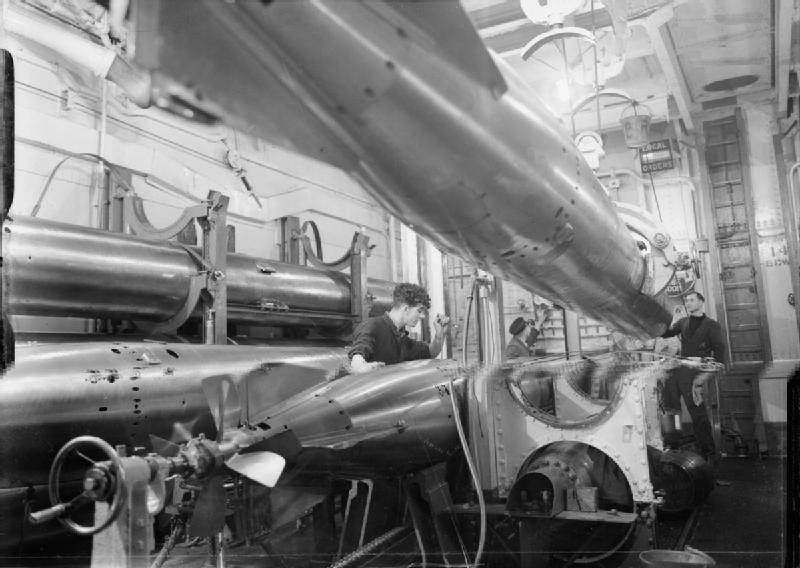
The torpedo weight was 2 850 kg, they carried 337 kg of explosives to 13 700 m range (almost 75 kb) with 35 nodes speed, or almost 18 kbt 300 nodes speed.
Reservation
It is a pleasure to describe the armored protection system of post-war British battleships and battlecruisers, since it was very simple and understandable. A rather complicated and multi-level booking of ships from the time of the WWI was replaced by the American “all or nothing”. The protection was based on a vertical armor belt of length 159,1 m (with a total length of the ship 259,25 mm along the waterline) and height 4,34 m - in normal displacement it lowered 1,37 m below and rose 2,97 m above the waterline. At the same time, the armor belt had an inclination of 18 degrees, and also - it was internal, that is, it did not protect the board in contact with the sea, but was deepened into the hull so that its upper edge defended by 1,2 m from the side. In the areas of the cellars of the towers of the main caliber (over the length of 78,9 m), the thickness of the armor belt was maximum and was 356 mm, otherwise - 305 mm. In general, the belt fully protected areas of the towers of the main and anti-mine calibers, engine and boiler rooms of the ship. A single armored deck rested on its upper edge: however, the angle of these bevels was so insignificant (only 2,5 degrees!) That it was fit to talk about a single horizontal deck, but formally they were nonetheless. The thickness of the deck, like that of the armor belt, was differentiated: above the cellars of the main-caliber guns (that is, apparently over the 78,9 meter section of the 356 mm side armor), it had 203 mm, sinking into the stern successively to 172, 152, 141 and 102 mm (the last, four-inch thickness of the deck had above the aft boiler and engine rooms), while the areas of the anti-mine caliber towers covered 178 mm armored deck. The citadel was closed by traverses 305 mm thick ahead and 254 m in the stern, but there were still two additional 127 mm bulkheads, so that the aggregate protection was not so bad.
However, something was defended outside the citadel as well — the underwater torpedo tubes (and where to go without them), located in front of the citadel, had protection from 152-mm armor, traverse and armor deck of the same thickness. The steering machine was protected by a 127 mm deck and a 114 mm by traversing. Most likely, this was all, although some sources nevertheless indicate that, apart from the above, there were also lower decks outside the citadel (probably passing below the waterline) in the bow and stern, their thickness was 152 mm and 127 mm, respectively.
Artillery had a very strong defense. The forehead, side plates and the roof of the towers were defended, respectively, with 432 mm, 330 mm and 203 mm armor. The barbety had a thickness of 356 mm, however, closer to the diametral plane, where the barbet was overlapped by an adjacent one, or superstructure, its thickness was reduced to 280-305 mm. But on the conning tower, it can be said, they saved it - 356 mm armor plates protected it only in frontal projection, on the sides and rear it had only 254 and 102 mm armor, respectively.
The anti-torpedo protection (which included an 44 mm armored disperser) was calculated to counter charges equivalent to 340 kg of trinitrotoluene. Its depth reached 4,26 m, not metal pipes (like Hud’s), but water (2 630 tons in total!) Were used as a working medium, while in peacetime it was supposed to keep PTZ compartments drained. Interestingly, for the rapid straightening of the roll, a system was provided for blowing individual PTZ chambers with compressed air.
Power plant
It was assumed that the vehicles of the ship will develop 160 000 hp, while its speed will be ... alas, it is not entirely clear how much, because sources usually indicate the spread of 31-32 knots. However, even the lower limit is very good, and, of course, gave the British battlecruiser many tactical capabilities of a high-speed ship. However, the admirals, recalling the Lexington, were not satisfied with this speed and wanted more: however, reluctantly, agreed, because a further increase in speed required a significant reduction in other martial qualities, which nobody wanted to go to. It’s not quite clear what range the G-3 would have if it was built, but given the impressively large maximum fuel reserve in the 5 000, it would hardly be small, and it could easily have made the initially desired 7 000 miles on 16 knots or so. “Hood” with a maximum fuel capacity of about 4 000 t was able to overcome 7 500 miles on 14 nodes.
Layout
It must be said that the first look at the layout of the G-3 battle cruisers immediately recalls a rather old saying: “A camel is a horse made in England.” Why, well, why did the British need to abandon the normal and absolutely sensible placement of the towers “two in the bow, one in the stern” in favor of ... this ?! However, oddly enough, the British had very serious reasons for putting the third tower in the middle of the building.
I must say that the first design iterations of battleships and battlecruisers of the British were carried out in a completely traditional manner.
But ... the fact is that at that time in all British "capital" ships, according to the "Hood" inclusive, the charging compartments of the main caliber were located above the projectile. This was due to the fact that the ship's hold is relatively compact, and the shells occupy a much smaller volume than the powder, which should throw them out of the gun barrels. That is why the charge storages were always located above the slug compartments.
But now the British saw a flaw, because it was the powder “depots” that posed the greatest danger to the ships — fires followed by detonation in the battle of Jutland, according to authoritative commissions, caused the penetration of fire into the powder, and not into the shell cellars. In general, on test shells proved to be somewhat more resistant to the effects of a shock wave and flame. Therefore, the British came to the conclusion that the location of the charging compartments at the very bottom, under the storage of shells, will provide the newest battleships and cruisers with much better survivability than was possible before. But alas, it was impossible to swap the storage of shells and charges with the traditional layout. That is, it would certainly be possible, but the layout ceased to be rational, it was necessary to lengthen the citadel, which led to an increase in displacement, etc., and so it was until someone suggested exactly the scheme we see in the final project “G-3”. The location of the three 406-mm towers in close proximity to each other helped to place the powder cellars under the shell, without sacrificing other characteristics of the ship. This was the reason why the British adopted for their newest battleships and battlecruisers such a seemingly strange arrangement of artillery of the main caliber.
However, it should be noted that the most extravagant layout was still not the battle cruisers of the project “G-3”, but the battleships “N-3”, which the Admiralty was going to lay a year after the battle cruisers
As it is known, on the warships, the placement of boiler rooms closer to the stem was considered, and the engine rooms - to the stern stem, that is, steam engines (or turbines) were located behind the boilers, closer to the stern. The same was true of the G-3 battlecruisers. However, on the battleships "N-3" the British managed to swap them - that is, after the third tower, they first went to the engine rooms, and only then - the boiler rooms!
Comparison with "classmates"
After studying the projects of post-war battlecruisers (the last military ones for Germany), we come to the conclusion that the British G-3 is clearly superior to the German, American and Japanese ships of the same class. His nine 406-mm guns, at least on paper, were almost as good as the most heavily armed Amagi, while the G-3 was superior to the Japanese in speed by one knot and simply had an incomparably more powerful reservation. American “Lexington” at a meeting with the “G-3” could count only on the “retreat to the prepared positions”, or rather to run, because the speed was the only parameter by which this battle cruiser had superiority over the “G- 3 ”(33,5 knots vs. 31-32). But in practice, he most likely would not have succeeded, but in a battle the “American” simply had no chance, only hope for a miracle.
The most intelligible chances of success against the G-3 would have been that the German battleship did, but the nine 406-mm English ship still looked preferable to the 6 * 420-mm German, and the 350 mm belt of the latter, though exceeding the length of 356 mm the “G-3” section, but was significantly lower, and the second armored belt was only 250 mm. It should not be forgotten that the Germans used vertical plates, while the British planned to set them at an angle, and the reduced thickness of the British defense was 374 and 320 mm for the 356 mm and 305 mm sections, respectively. But most importantly, the G-3 had incomparably more powerful horizontal protection. In the previous article, we indicated that the thickness of the main armored deck of the German ship was 30-60 mm, but this question requires further clarification, and perhaps it still had 50-60 mm throughout. But, for obvious reasons, even if this is so, then such a thickness cannot be compared with the X-NUMX-102 mm armored "G-203". Of course, the German cruiser still had an armor (or just thick structural steel) deck in 3 mm, but such spaced armor has less durability than a single armor plate of the same thickness, and the advantage of G-20 is still overwhelming. In general, in general, it is the armor protection of the “G-3” that is the real “highlight” of the project, thanks to which it significantly surpasses the similar projects of other countries.
However, we can also see that the design of the last British battlecruiser also had significant drawbacks. And first of all it concerned, oddly enough ... the booking system, which we have just called the most impressive. But in fairness, it should be pointed out that only a section of the citadel that had 406 mm (356 mm reduced) vertical armor and 374 mm armored deck looked more or less acceptable protection against 203-mm shells. That would be enough, but the length of this section of the citadel is quite small - only 78,9 m or 30,4% of the total length of the waterline. The rest of the citadel, which had 320 mm reduced vertical armor, and 102-152 mm horizontal, was no longer sufficient protection against projectiles of this caliber. Also, the barbets of the towers of the main caliber, even in their 356 mm parts, were quite vulnerable, although it would not be so easy to pierce them: they had a circular cross section, so getting into the barbet at an angle close to 90 degrees was very difficult.
The vertical armor belt “G-3” was “sunk” into the board, which allowed saving on the mass of the armor decks, as it made it already, but at the same time reduced the volume of the reserved space: while the enemy shells could cause serious (although not threatening to destroy the ship) damage without even breaking through the armor belt. The ship’s extremities were completely unprotected, which was more or less acceptable in the battle of battleships, but it was a major drawback in most other combat situations - even relatively minor damage from high-explosive bombs and shells could cause extensive flooding, a strong trim on the bow or stern and as a result , a significant drop in combat effectiveness of the battlecruiser.
But still, in general, it should be stated that in the G-3 project, the British were as close as possible, much closer than other countries, to the concept of a high-speed battleship during the Second World War. And if something didn’t work out for them, it’s not because the English admirals and designers didn’t understand something, or didn’t take it into account, but only because at the given normal displacement (48 500) on 20 It’s absolutely impossible to design and build an 30-node battleship that carries an 406-mm gun and is well protected from projectiles of the same caliber. The British knew exactly what they wanted, understood the inaccessibility of their desires and were forced to make conscious compromises. And we can justifiably say that as a result of these compromises, it turned out that the project of the cruiser G-3, though not perfect, but extremely successful and well-balanced.
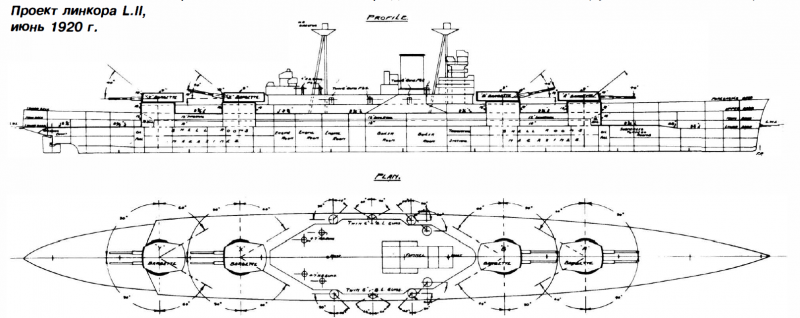
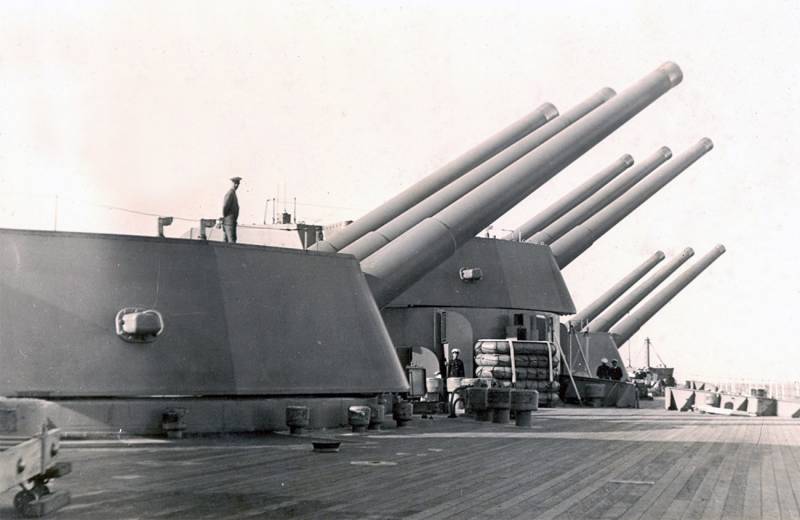
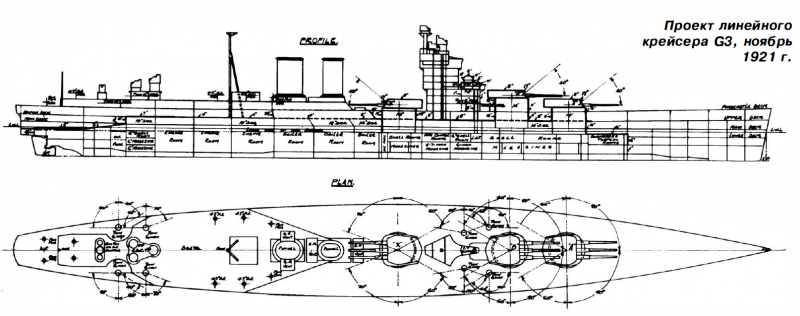
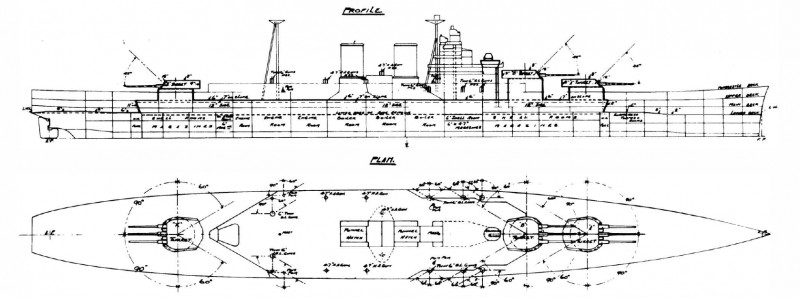
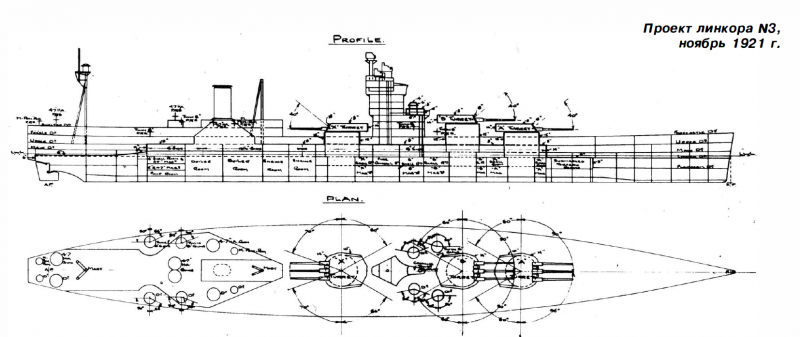
Information